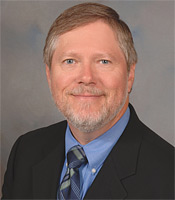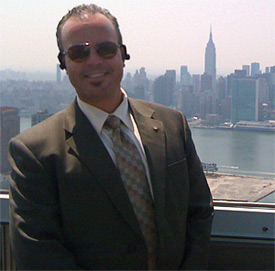ATSC 3.0 Plans for Television's Future
WASHINGTON—It was just two years ago that high-powered TV stations in the U.S. turned off their analog transmitters for good and rode the digital wave into the future. Much of the dust from that event has settled and, although the past two years haven't been stellar for broadcasters, the transition was not nearly as painful as some had predicted.
Mark Richer, ATSC president One of the forces behind the transition is the standards body once known as the Advanced Television Standards Committee and now known as the Advanced Television Systems Committee. The ATSC, based in Washington, has turned its attention again to the future of television by working on a new standard called ATSC 2.0—and is looking beyond that to an ATSC 3.0 standard.
MITIGATING FACTORS
Technology of the future is a rapidly moving target, so there is not yet a definite date for the completion of ATSC 2.0, and ATSC 3.0 is much further out.
"Based upon the work of our planning team on Next Generation Broadcast Television (NGBT) led by Jim Kutzner [of PBS], the ATSC board has formed a new technology group to develop the NGBT suite of standards," said Mark Richer, president of the ATSC. "The time frame for completion and implementation is highly dependent on the regulatory, technology and business environment."
Richer had some thoughts on how a final standard might shape up.
"ATSC 3.0 is not likely to be backwards compatible and therefore must provide improvements in performance, functionality and efficiency significant enough to warrant the transition to a new system," he said.
Kutzner is the senior director for advanced technology at PBS, with decades of broadcast experience. He will work with broadcasters and engineers across the U.S. and the world to put together a team to study the issues and ultimately produce a standard. The ATSC 3.0 committee will be known as the Technology and Standards Group 3 or "TG3" for short, and membership in TG3 is open to all participating ATSC members.

Jim Kutzner An early idea of what the future might hold for the process of developing new standards is likely to happen at the "Future of Broadcast Television Summit," to be held next month in Shanghai, China. Both Richer and Kutzner are expected to be among the leaders at that conference, which will be attended by top-echelon planners and engineers from major broadcasters and TV standards bodies from around the world.
ARC OF THE PROCESS
Without a team assembled or formal meetings scheduled, Kutzner knows that it's impossible to pin down the end of a process that has yet to begin, but he has some thoughts on the arc that the process will take.
"We first need to establish the system requirements, i.e., what do we [collectively] want and need this new system to do?," he said. "Then we need to establish a set of potential candidate technologies for the various portions of the new system that can meet the requirements, and the new system will build in layers in the same manner as the current system."
Most of the big cellular carriers now provide television services to their customers in direct competition to over-the-air broadcasters, and ATSC 3.0 will take time to examine that shifting relationship between broadcasters and viewers.
"The current ATSC standard already includes broadcast to mobile devices such as mobile phones and tablets, and this will be an important aspect of any new system," Kutzner said. "Whether we should move the physical layer [the transmission system] toward other mobile services is a topic that the planning team began to address, but TG3 needs to explore further. There is tremendous efficiency in broadcast (one to everyone) and we don't want to abandon that ideal, but there may be good reasons to incorporate physical layer elements or concepts from other delivery technologies."
Verizon, AT&T and other wireless carriers are too big to go away anytime soon and they see delivery of programming as another revenue stream for their growing networks. Some in the industry would like the ATSC 3.0 committee to invite these wireless carriers to the conference table.

Gregory J. Herman "We believe that there is an exceptionally bright future for collaborative services, provided by existing broadcasters, in concert with other wireless services, if we as an industry are able to quickly embrace the concept and begin deploying the transmission infrastructure," said Gregory J. Herman, president of Spectrum Evolution, an organization formed by a combination of low-power broadcasters and telecom executives.
"Much has been written about the absolute need for a broadcast architecture to be included in any next generation mobile broadband deployment, to create real efficiencies in the transmission of live video and/or commonly consumed content." Herman said. "As opposed to eviscerating the broadcast industry with oppressive re-packing and auction strategies that may yield no tangible benefits to the public for a decade or more, imagine the real benefits if existing broadcasters were in effect, broadcasting local content, commonly consumed data and video to all devices, both fixed and mobile."
No matter how ATSC 3.0 develops, Herman sees the need to make a clean break with the current ATSC 1.0 standard.
"Given the how, when and why, the existing ATSC standard was developed, departing from any attempt to maintain backwards compatibility with it is probably essential for it to be truly successful," he said. "ATSC 3.0, whatever it actually becomes, needs to represent the absolute best-of-the-best in technology, features and performance."
As he looks into a future process of meetings, reports, investigations and testing, Kutzner also recognizes the promise and the quicksand that lay hidden on either path. When do you abandon something familiar and functional, and how can you promise that a laboratory-tested technology can meet real-world expectations?
"A new non-backward-compatible system must be worth the expense, the time, and the effort," Kutzner said. "We believe that significant bandwidth efficiency can be achieved through a number of means, that image and aural quality can leap well past HD, and that new features can be implemented."
"Whether these add up to a new system worthy of the effort is something that the industry will need to decide," he said.
Bob Kovacs is a television engineer and video producer. He can be reached at bob@bobkovacs.com.
Get the TV Tech Newsletter
The professional video industry's #1 source for news, trends and product and tech information. Sign up below.
Bob Kovacs is the former Technology Editor for TV Tech and editor of Government Video. He is a long-time video engineer and writer, who now works as a video producer for a government agency. In 2020, Kovacs won several awards as the editor and co-producer of the short film "Rendezvous."

